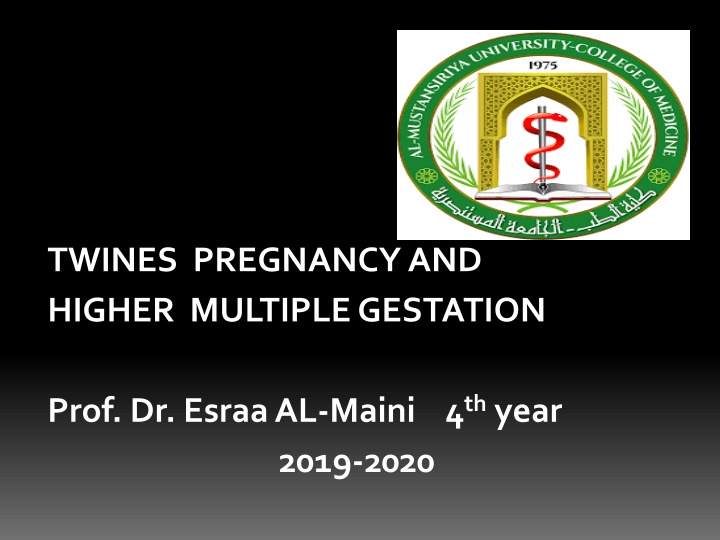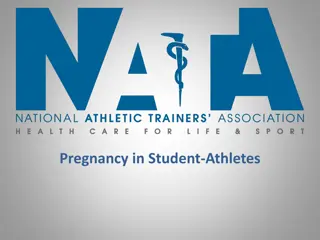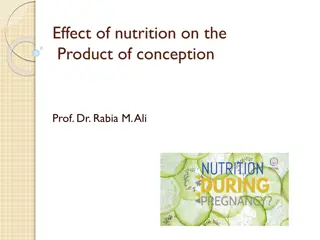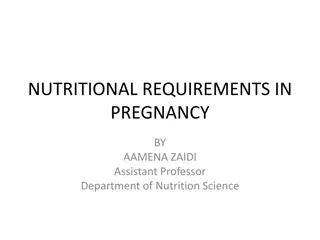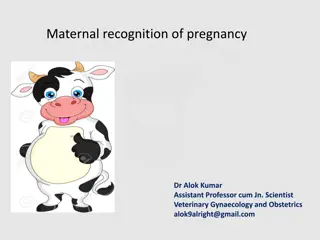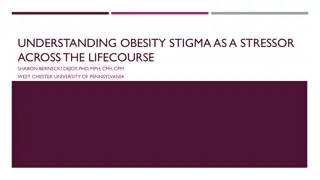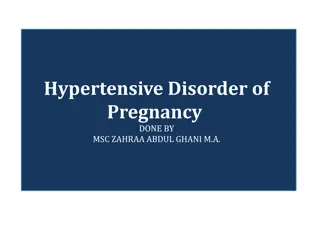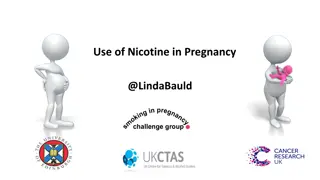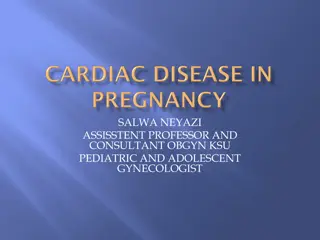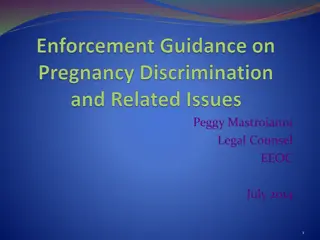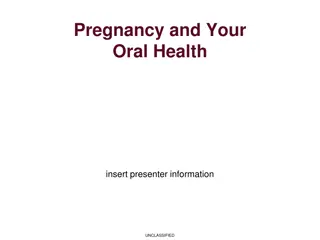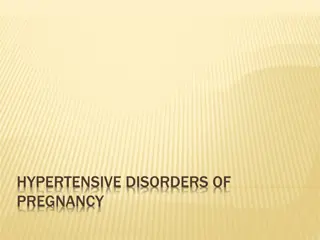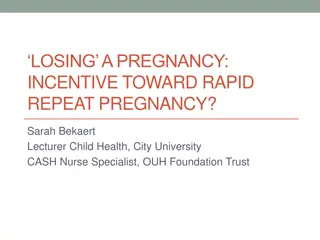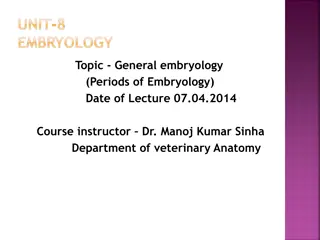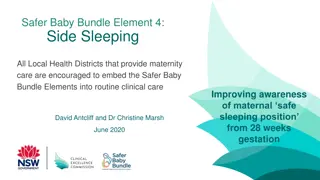Multiple Gestation in Pregnancy
Multiple gestation in pregnancy refers to the occurrence of twins, triplets, or more. Factors such as increasing maternal age and assisted conception contribute to the rising rates of multiple pregnancies. Classification based on number of fetuses, zygosity, chorionicity, and amnionicity helps in understanding the different types of multiple pregnancies, such as dizygotic and monozygotic twins. Knowing the risks and identifying the types of multiple pregnancies is essential for effective management and care.
Download Presentation

Please find below an Image/Link to download the presentation.
The content on the website is provided AS IS for your information and personal use only. It may not be sold, licensed, or shared on other websites without obtaining consent from the author.If you encounter any issues during the download, it is possible that the publisher has removed the file from their server.
You are allowed to download the files provided on this website for personal or commercial use, subject to the condition that they are used lawfully. All files are the property of their respective owners.
The content on the website is provided AS IS for your information and personal use only. It may not be sold, licensed, or shared on other websites without obtaining consent from the author.
E N D
Presentation Transcript
TWINES PREGNANCY AND HIGHER MULTIPLE GESTATION Prof. Dr. EsraaAL-Maini 4thyear 2019-2020
Rate: Rates continue to increase and now 3% of live births. The incidence of multiple pregnancy varies worldwide, In the UK the rates of multiple pregnancy are approximately 16 per 1,000 births. The majority (97 99%) of these were twin pregnancies Remainder being predominantly triplet pregnancies.
Risk factors of multiple pregnancy : 1-Increasing maternal age : 1 in 10 women aged over 45 giving birth in the UK. 2-Assisted conception is also responsible for the increasing incidence of multiple pregnancies, with approximately 1 in 5 successful in vitro fertilization (IVF) - directly proportional to the number of embryos transferred - procedures resulting in multiple pregnancy.
Multiple pregnancy may be classified according to: 1-Number of fetuses: twins, triplets, quadruplets, etc. 2-Number of fertilized eggs: zygosity. Twin pregnancy may be dizygotic (70%) monozygotic (30%). 3-Number of placentae: chorionicity. 4-Number of amniotic cavities: amnionicity.
Dizygotic twins 2/3(non- identical): Fertilization of two oocytes. This results in dichorionic diamniotic twins, They always have two functionally separate placentae (dichorionic), the placentae can become anatomically fused together and appear to the naked eye as a single placental mass. They always have separate amniotic cavities (diamniotic) The two cavities are separated by a thick three-layer membrane (fused amnion in the middle with chorion on either side The fetuses can be either same- sex or different-sex pairings.
Monozygotic pregnancies (identical) 30%: fertilization of a single ovum with subsequent division of the zygote. dichorionic diamniotic 10% If the zygote splits shortly after fertilization with in 3days the twins will each have a separate placenta Monochorionic diamniotic (20%) pregnancies occur when division of the zygote occurs between days 4-8 post fertilization. The vast majority of monochorionic twins have two amniotic cavities (diamniotic) but the dividing membrane is thin, as it consists of a single layer of amnion alone Monochorionic monoamniotic (1%) pregnancy occurs when division occurs between days 8 -12 post fertilization Conjoined twins occur when division of the zygote happens after day 13 after formation of
-All the physiological changes of pregnancy are exaggerated in multiple gestations. Including increased cardiac output, volume expansion ,relative haemodilution, diaphragmatic splinting, weight gain and lordosis, -The minor symptoms of pregnancy may be exaggerated, such as nausea and vomiting and heartburn. -However, for women with pre-existing health problems, such as cardiac disease a multiple pregnancy may substantially increase their risk of morbidity. -Regardless of chorionicity and amnionicity, complications in multiple pregnancies are higher , include pTL, (FGR), cerebral palsy and stillbirth. The maternal risks are also increased and include HT, TED disease and APH and PPH
Complications of dichorionic diamniotic pregnancies : 1-preterm delivery and miscarriage : Either spontaneous or iatrogenic due to pregnancy complications -60% of twin pregnancies result in spontaneous PTL . 20 25% (NICU) admissions is product of multiple pregnancy
2-Perinatal mortality The overall infant mortality rate for twins is approximately 5.5 times higher than for singletons mainly extreme prematurity The stillbirth rate is increased
-Up to 25% of twins may suffer an early demise and subsequently vanish if this take place before 13weeks gestation it will not increase the risk to the other twin . - Between 13-20 weeks the fetus shrink and become dehydrated and flattened (fetus papyraceus)
In dichorionic twins if death occur after 20 weeks intrauterine death of one fetus may be associated with the onset of labour, although in some cases the pregnancy may continue uneventfully and even result in delivery at term Or may be associated with Maternal complications such as DIC but at very low incidence Careful fetal and maternal monitoring is required.
In monochorionic twin Death of one of co twin after 20 weeks may result in immediate complications in the survivor 30% .These include : 1-death 2-Brain damage with subsequent neurodevelopmental handicap This due to; Acute hypotensive episodes, secondary to placental vascular anastomosesbetween the two fetuses The acute release of vasoactivesubstances
3-Fetal growth restriction The risk of FGR is higher in each individual twin In a dichorionic pregnancy; there is a 25% chance that at least one of the fetuses will be small for gestational age. In monochorionictwins is almost double that for dichorionic twins.
This increased incidence of growth restriction creates several management difficulties as the interpretation of and performing detailed Doppler studies, become increasingly difficult as gestation progresses. In fetus is growth restricted , the main aims of antenatal care become prediction of the severity of impaired fetal oxygenation and selecting the appropriate time for delivery.
In singletons, this is a balance between the relative risks of intrauterine death versus the risk of neonatal death or handicap from elective preterm delivery. IN TWIN ; The potential benefit of expectant management or elective delivery for the small fetus must also be weighed against the risk of the same policy for the normally grown co- twin.
In dichorionic twin pregnancies where one fetus has growth restriction, elective preterm delivery may lead to iatrogenic complications of prematurity in the previously healthy co twin. In general, delivery should be avoided before 28 30 weeks gestation, even if there is evidence of imminent intrauterine death of the smaller twin
however, this may not be applicable in the management of monochorionic twins: The death of one of a monochorionic twin pair may result in either death or handicap of the co-twin , As the damage potentially happens at the moment of death of the first twin The timing of delivery may be a very difficult decision, Below 30 weeks gestation, The aim is to prolong the pregnancy as far as possible without risking the death of the growth- restricted twin.
Monochorionic monoamniotic twin pregnancy Is associated with high morbidity and mortality due to: - secondary to cord entanglement resulting in fetal loss or neurological morbidity, -increased risk of congenital anomalies , -Discordant birth weight affects approximately 20% of surviving twin.
Complications unique to monochorionic twin pregnancies 1-Twin-to-twin transfusion syndrome Although vascular connections are found in nearly all monochorionic twins -10% of monochorionic diamniotic pregnancies -5% of monoamniotic pregnancies will subsequently develop TTTS. Due to the development of abnormal unbalanced vascular anastomoses between two placentas .
Four types of vascular connections have been identified in monochorionic pregnancies: Arteriovenous (AV), Venoarterial (VA), Arterioarterial (AA) and Venovenous (VV). An equal number of bidirectional anastomoses results in balanced connections and TTTS does not occur under these circumstances , unbalanced with more AV connections occurring in one direction than the other, alterations in the hydrostatic and osmotic forces occur, resulting in the manifestations seen in TTTS. AA anastomoses are protective against the development of TTTS.
TTTS is diagnosed based on the following ultrasound criteria: 1-Single placental mass. 2-Concordant gender. 3-Oligohydramnios with maximum vertical pool (MVP) less than 2 cm in one sac and polyhydramniosin the other sac (MVP >8 cm). 4-Discordant bladder appearances. 5-Haemodynamic and cardiac compromise. TTTS may be graded in severity in to 5 Stages depend on : visualized bladder liquor amount abnormal DopplersOne or both fetuses have hydrops or died.
2-TAPS twin anaemiapolycythaemia sequence (TAPS) -Rarer chronic form of TTTS - Inn which there is a large inter-twin haemoglobindifference - The oligohydramnios polyhydramniossequence is not seen. - Due to small (<1 mm) unidirectional AV anastomoses without accompanying AA anastomoses,lead to the gradual development of anaemiain one twin and polycythaemiain the other twin. 1-Due to small AV haemodynamiccompensation so no oligohydramnios polyhydramnios 2-Severe polycythaemiacan occur, leading to fetal and placental thrombosis hydrop-s fetalis in the anaemic twin. 3-Rarely, mirror syndrome, the combination of fetal hydrops and maternal pre-eclampsia
4-Twin reversed arterial perfusion sequence This rare condition (complicating 1 in 35 000 pregnancies) arises in monochorionictwins with two umbilical cords often linked by large arterio arterial anastomoses cause fetal structural abn.dueto poor oxygenated blood to recipient cause under developed of cephaladpart of body (a cardiac twin)
in Monochorionic pregnancies; Serial ultrasound is recommended to assess growth The aim of ultrasound assessment is to 1-detect early signs of TTTS 16-24 weeks after 24 for detect IUGR 2-Enabling early intervention 3-Optimizing outcomes
When TTTS is confirmed, patients should be referred to tertiary center Management options include Expectant management; amnioreduction; septostomy; selective feticide, fetoscopic laser ablation of vascular anastomoses. Fetoscopic laser ablation is now generally considered the definitive treatment for severe (stage II or above) TTTS between 16 and 26 weeks gestation ,twice as likely to survive and had an 80% reduction in neurological morbidity, neonatal death)
Above 26 weeks, delivery may be considered. The procedure is performed either under local anaesthetic with intravenous sedation, with regional anaesthesia or occasionally under general anaesthesia. Following the laser therapy, amnioreduction is performed until the amniotic fluid volume appears normal by ultrasound assessment.
Routine antenatal(NICE) women with uncomplicated dichorionic twin pregnancies be offered at least 8 antenatal appointments at least 9 antenatal appointments for uncomplicated monochorionic diamniotic twin pregnancies
A- Minor symptoms of pregnancy are more common, but management is again unchanged compared to singletons. B- screening for HT and GDM , APH and TED however, the management is the same as for a singleton. C- Due to the increased fetoplacental demand for iron and folic acid, many would recommend routine supplementation in multiple pregnancies.
D-Estimation of GA in multiple pregnancy Women should be offered a first trimester scan when the crown rump length (CRL) equal to 11 weeks 0 days to 13 weeks 6 days , Allow accurately estimate gestational age
E-Ultrasound scaning in twin pregnancy 1-GA 2-Determination chorionicity is determined by ; assessing the number of placental masses and assessing for the lambda or T sign and membrane thickness .
3--Prediction of risk of TTTS Assessment of the a-wave in the DV at 11 13 weeks gestation may help identify monochorionic pregnancies at risk of severe TTTS as reversed a-wave is associated with an increased risk of developing severe TTTS, as well as other complications including aneuploidy ,but due to high false positives, this is not widely advocated or must be interpreted with caution.
4-At this stage the fetuses are mapped and it is documented clearly which fetus is where, to ensure consistency with future scans throughout pregnancy, for example, triplet ,two Fetuses maternal upper right side.
5-To screen for Downs syndrome. Both amniocentesis and chorionic villous sampling (CVS)can be performed in twin pregnancies, but in dichorionic pregnancies, it is essential that both fetuses are sampled. Calculate the risk of Down s syndrome With dichorionic pregnancies Calculate the risk of Down s syndrome for each baby. With monochorionic pregnancies the risk of Down s syndrome is calculated for the pregnancy as a whole
6- Anomaly scan -Higher rates of congenital anomalies compared to singleton fetuses. -Monozygotic 2-3 times have structural defects than dizygotic - In 5 20% of cases the defect is present in both twins. -Multiple gestations with an abnormality in one fetus can be managed expectantly or by selective fetocide of the affected twin result in 5-10% the risk of loss of the normal twin as complications of procedures.
In cases where the abnormality is non-lethal but may well result in handicap, the parents may need to decide whether the potential burden of a handicapped child In cases where the abnormality is lethal, it may be best to avoid such risk to the normal fetus, unless the condition itself threatens the survival of the normal twin. Anencephaly is a good example
In monochorionicpregnancies As there are potential vascular anastomoses between the two fetal circulations, intracardiac injections cannot be employed as fetocide ,but it requires adifferent technique such as cord occlusion which associated with a higher complication rate.
F-Growth assessments Multiple pregnancies are at high risk of FGR. As a result, fetal weight should be calculated from 20 weeks gestation at a maximum of 4 week intervals. A growth discrepancy of 25% or greater should be considered clinically significant a tertiary referral opinion G- Indications for a tertiary level fetal medicine opinion 1-Discordant fetal growth, 2-fFetal anomaly,3-Discordant fetal death 4- TTTS.
H-Delivery plan 1-should be discussed with the patient, ideally throughout pregnancy, and documented early in the third trimester because ahigh prevalence of preterm delivery. The discussion with the patient should include mode for delivery, gestation for induction of labour if no spontaneous onset of labour, process for delivery of twin one and twin two including internal podalic version, risk of caesarean section, complications following delivery including postpartum hemorrhage 2-Desire to breast feed or not.
I-Intrapartum management 1-pre agreed birth plan. 2-Continuous fetal heart monitoring. Two neonatal resuscitation trolleys, two obstetricians and two paediatricians are available and that the special care baby unit and anaesthetist are informed well in advance of the delivery. 3-Analgesia, ideally in the form of an early epidural, to allow manipulation for 2nd twin 4. A standard oxytocin solution for augmentation should be prepared , for use for delivery of the second twin and in anticipation of postpartum haemorrhage 5-Portable ultrasound.
Uncomplicated dichorionic diamniotic pregnancies vaginal delivery is advocated provided the presenting twin is cephalic. The risk of requiring emergency caesarean section for delivery of the second twin is approximately 4%. If the second twin is non-vertex, 40% of twins, a vaginal delivery can be safely considered.
If the second twin is a breech, the membranes can be ruptured once the breech is fixed in the birth canal. A breech extraction may be performed if fetal distress occurs or if a footling breech is encountered, but this requires considerable expertise. Complications are less likely if the membranes are not ruptured until the feet are held by the operator.
Where the fetus is transverse, external cephalic version can be successful in more than 70% of cases. The fetal heart rate should be closely monitored, ultrasound to demonstrate the position of the baby. If external cephalic version is unsuccessful so internal podalic version can be undertaken is performed by identifying a fetal foot through intact membranes. The foot is grasped and pulled gently and continuously into the birth canal. The membranes are ruptured as late as possible. This procedure is easiest when the transverse lie is with the back superior or posterior. If the back is inferior or if the limbs are not immediately palpable, ultrasound may help to show the operator where they would be found.
Time of delivery in dichorionic twin pregnancies delivery from 37weeks gestation is advocated. Women with uncomplicated monochorionic twin pregnancies should be offered elective delivery from 36 weeks gestation and this should be performed after a course of antenatal corticosteroids has been given. Continuing uncomplicated twin pregnancies beyond 38 weeks gestation increases the risk of intrauterine fetal death. The indications for instrumental delivery of the second are as for singletons.
The indications for elective caesarean section are :. 1-Congenital anomalies associated with significant risk of cephalopelvic disproportion (including conjoined twins) 2- monoamniotic twins 3-monochorionic pregnancies, complicated by placental anomalies associated with increased perinatal mortality (i.e. TTTS or TRAP), are generally delivered at 34 36 weeks and usually by caesarean section 4-Triplet pregnancies elective birth 5-Those with previous caesarean section scars are probably best delivered by repeat caesarean section because of the greater risk of scar dehiscence/ rupture due to both uterine distension and intrauterine manipulation of the second twin. 6-Caesarean section has been advised when the first twin is breech, rare risk of interlocking twins 7-Caesarean section for second twin is occasionally indicated for disproportion, usually where the second twin is much bigger than the first 4%
Triplet pregnancy The incidence of spontaneous 1 in 6,000 8,000 births. Also due assisted fertility. Triplets are associated with a high morbidity and mortality. Preterm they have an average gestation of 34 weeks Low birthweight of 1.8 kg Cerebral palsy rate
NICE recommends that women with uncomplicated monochorionic triamniotic and dichorionic triamniotic triplet pregnancies be offered at least 11 antenatal appointments It is not recommended to prolong pregnancy beyond 36 weeks gestation triplet pregnancies elective c/s birth
